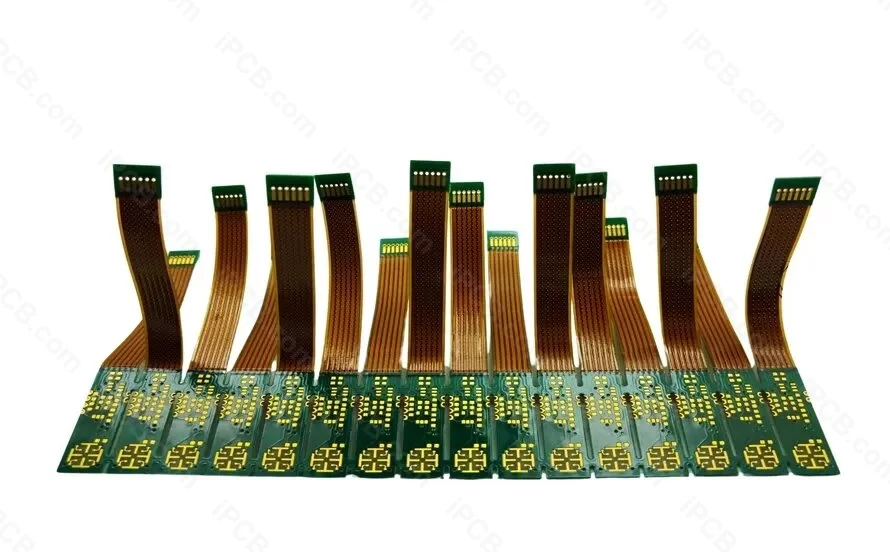Screen rigid-flexible PCB is a design that combines a rigid area and a flexible area on the same circuit board.The rigid part is generally used to transport electronic components that require a fixed position and a stable support, such as Chips, resistors, capacitors, etc.providing mechanical strength and stable electrical connections to the entire circuit. flexible part gives the circuit board the characteristics of bendable and foldable. This is essential for screen-related applications, because it may be necessary to bend the screen during use, such as foldable mobile phone screens, curved screens, etc.
Compared with traditional rigid PCB or flexible PCB, screen FPC PCB have obvious characteristics advantages. It in addition to overcoming the limitations of rigid PCB that cannot be bent, it also solves the shortcomings of flexible PCB when heavier components are transported or a stable structure is required. This combination allows the printed circuit board to meet the complex functional requirements of the screen while adapting to different product shape designs.
The key role of Screen rigid-flexible PCB for displays in display technology
1.In screen applications, the quality and speed of signal transmission are essential.PCB Screen rigid and flexible PCB can realize efficient signal transmission by accurately transmitting the signals of different chips and circuit modules to each Pixel of the screen.
2.For foldable phones, the circuit board behind the screen can bend naturally when the phone folds up, adapt to the new shape, and quickly return to normal operation once unfolded. The flexible part of the FPC printed circuit board of the screen may be deformed when bending the screen, and the circuit will not be interrupted or the Signal will be interrupted due to repeated mechanical stress. This feature is of great importance to improve the life and user experience of the screen.
3. When designing screen-related products, space plays an important role. The FPC PCB screen can be customized according to the inside of the product. The rigid part is placed in an area where there is more space and a stable support is needed, while the flexible part can deftly bypass the other components and take full advantage of the limited space.

Screen rigid-flexible PCB
The manufacture of Screen rigid-flexible PCB requires a combination of rigid and flexible printed circuit board manufacturing technologies, as well as special processing. For rigid areas, traditional PCB manufacturing processes, such as copper-coated plate engraving, drilling, electroplating, etc., can be utilizes. The flexible area requires the use of special flexible materials and processes. In the production process, the flexible substrate must first be connected to the rigid part. This process must ensure the tightness and strength of the adhesive. Then the circuit is printed and etched. The engraving process here must be adapted to the characteristics of the flexible material to avoid damage it. In the manufacture of multilayer screen FPC PCB, the alignment between the layers and the compression are important steps. Due to the presence of rigid and flexible zones, the thicknesses- and the material differences between the layers are large, and high-precision inter-layer alignment technology is needed to ensure the accuracy of the electrical connections between the layers .During the pressing process, parameters such as pressure and temperature should be adjusted according to the material properties of different areas to ensure the quality of the entire printed circuit board.
Choice of materials for Screen rigid-flexible PCB
In rigid areas, commonly used materials include FR-4 fiberglass, epoxy resin, copper-coated laminate, etc. this material has good mechanical strength, electrical insulation and stability, and can meet the requirements of load-bearing components and stabilization circuits. The base material of the flexible zone is a polyimide (PI) film. The PI film has excellent flexibility, high temperature resistance, electrical insulation and chemical properties stability. It can maintain good performance in repeated bending and is an ideal Substrate for flexible PCBs. In the connection part of the rigid zone and the flexible zone, special materials and connection techniques must be used. For example, a flexible conductive adhesive or special adapter connectors can be used to make electrical connections while ensuring the reliability of mechanical connections.
In the field of foldable mobile phones, the screen FPC printed circuit board has become one of the core technologies. For example, on Samsung's Galaxy Fold series mobile phones, the internal printed circuit board perfectly adapts to the screen folding function by combining rigidity and softness, offering users a completely new experience. In with products such as tablets and laptops, more and more manufacturers have begun to use this printed circuit board technology to realize the foldable or foldable design of the screen, which supports the multifunctionality and portability of the product.
Screen rigid-flexible PCB, as an innovative electronic Technology, has wide applications in fields related to theécran. From the design to the manufacture through the choice of materials, each link is constantly developed and improving. As electronic devices are evolving towards thinner, more flexible and more powerful printed circuits. This unique type of printed circuit board will continue to promote Innovation and progress in screen technology, bringing us a more powerful and beautifully designed electronic screen products. It has not only changed the way we use screens, but has also brought new development opportunities and new challenges to the entire electronics industry.